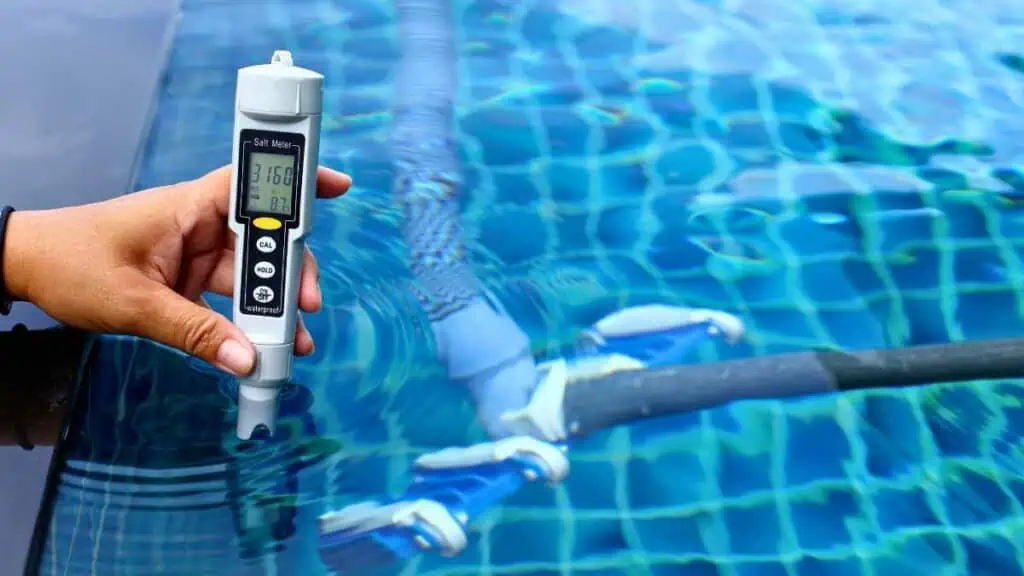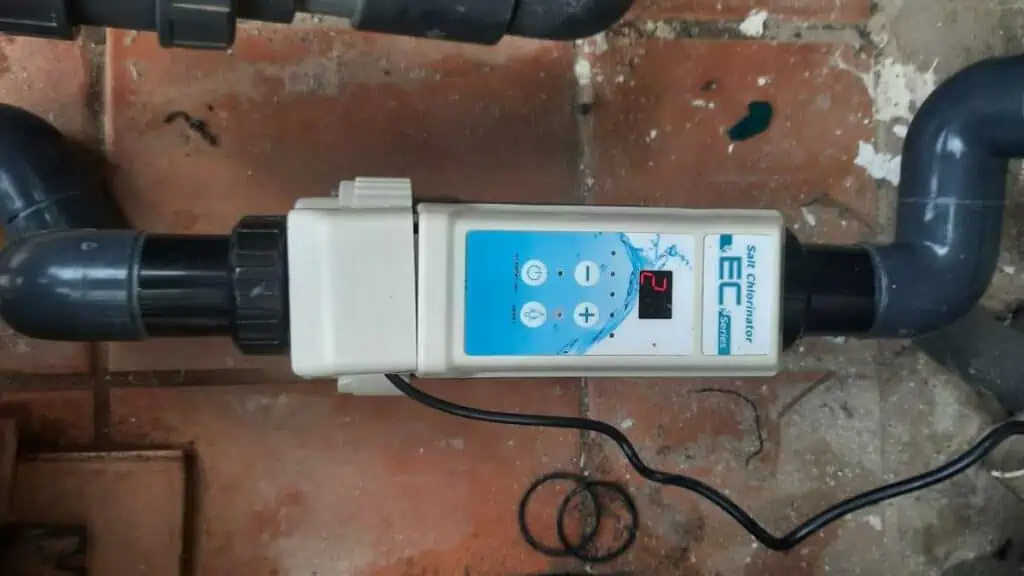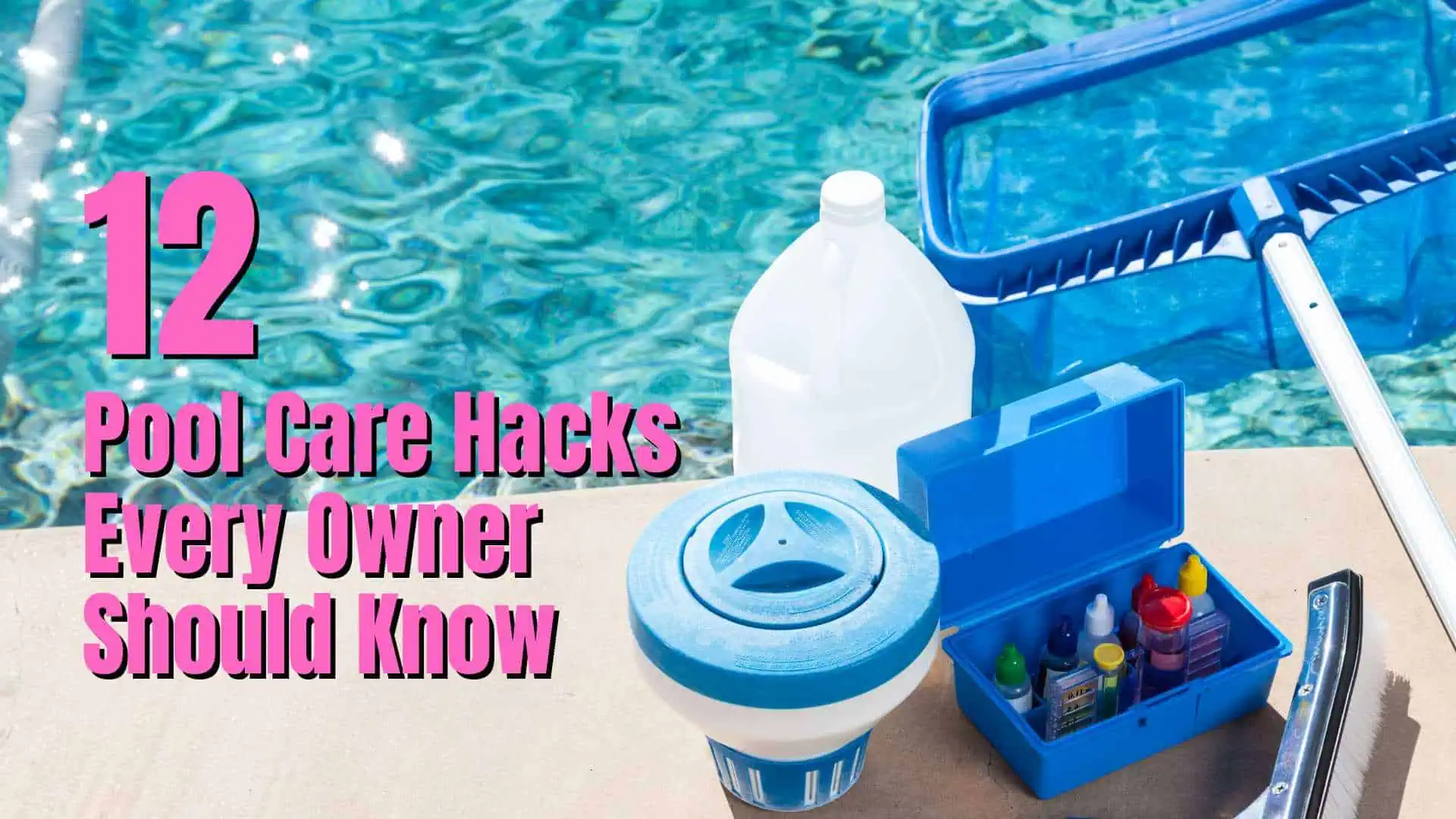Saltwater pools have gained popularity in recent years as a more natural and gentle way to keep pools clean with softer water, less skin and eye irritation, and reduced environmental impact. Another factor for their increased popularity has been the worldwide chlorine shortages and the resulting higher prices.
Additionally, saltwater pools require less maintenance and chemical adjustments than traditional chlorine pools, making them a popular choice for homeowners.
But exactly how do salt water pools work?
Although both a salt water pool and a traditional pool use chlorine as a sanitizer, the method the chlorine gets in the pool is different.
Instead of adding store-bought chlorine to the water as you do in a regular pool, a salt water pool relies mainly on an electrolytic chlorine generator. This generator separates the salt in the pool water into its primary elements, one of which is chlorine.
Let’s look at the science behind salt water pools and explore the many benefits they offer.

Key Takeaways
- Saltwater pools generate chlorine through an electrolytic process using sodium chloride (NaCl) rather than adding store-bought chemicals.
- The electrolytic chlorine generator separates salt into its primary elements, producing chlorine to sanitize the pool.
- Saltwater pools provide an indefinite sanitizing cycle, reducing chemical usage and providing softer water for swimmers.
How Do Salt Water Pools Work?
A saltwater pool is different from a traditional chlorine pool in that it uses salt to generate chlorine, providing a more natural and gentle swimming experience. Instead of manually pouring chlorine into the pool or adding tablets, a saltwater pool system constantly creates chlorine through an electrical reaction between the salt in the salt cell and the electrode in the generator.
The process that takes place in a saltwater pool system is called electrolysis. During this process, the salt, also known as sodium chloride or NaCl, is broken down or separated in the water.
This occurs as the water is pumped through the chlorinator system containing a salt cell – a plastic device with electrified metal plates inside. As the saltwater passes through these electrified plates, the salt is converted into chlorine.
The chlorine generated in a saltwater pool continuously kills bacteria and algae and then reverts back to salt, creating an indefinite cycle. This results in water that feels soft and silky to the touch.
While saltwater pools do produce their own chlorine, it’s still important to regularly test and maintain the appropriate levels of salt and other pool chemicals, including chlorine, to ensure the health and cleanliness of your pool.
The Salt Water System
The main components of a saltwater system include the Chlorine Generator, Salt Cell, and Control Box.
Chlorine Generator
The heart of a saltwater pool system is the chlorine generator. It utilizes a natural process called electrolysis to convert salt (sodium chloride or NaCl) into chlorine.
This process is responsible for maintaining a stable and consistent level of chlorine in your pool, ensuring better water quality and fewer irritants for swimmers.
Salt Cell
The salt cell, sometimes called a salt generator, is an essential component of a saltwater system. It’s responsible for breaking down or separating the salt in the water through the process of electrolysis.
This chemical reaction produces chlorine in the form of sodium hypochlorite and hypochlorous acid, which helps kill bacteria and keep the water clean and fresh.
The salt in the salt cell is constantly used and regenerated, making it a more eco-friendly and cost-effective option compared to traditional chlorination methods.
Control Box
Last but not least, the control box is the “brain” of your saltwater pool system.
It acts as the command center, monitoring and regulating the performance of your pool’s chlorine generator and salt cell.
The control box allows you to adjust the settings for chlorine production and provides useful information on the system’s status, such as salt levels and water temperature.

The control box is built into the salt generator on some models, which is the case with mine.
This post may help if you want to find out what is involved in converting to a saltwater pool.
Salt Water Pool Costs
Initial Investment
A salt water pool system uses a salt chlorine generator to convert salt into chlorine, which sanitizes the water through a process called electrolysis. The initial cost of installing a salt chlorine generator typically ranges from $1,000 to $2,500.
To convert an existing chlorine pool to a salt water pool, you can expect to pay $600 to $1,100 for an above-ground pool, and $1,100 to $2,200 for an inground pool.
I installed my salt generator myself for around $850 which took me about 2.5 hours from start to finish.
Salt Water Pool Cost Over Time
Although the initial investment of a saltwater pool system may seem expensive, the cost over time can be lower compared to traditional chlorine pools. Here’s a breakdown of ongoing saltwater pool expenses:
- Salt and Chemicals: Salt is added to the pool when needed, often only a couple of times a year. The cost of salt is relatively low, ranging from $5 to $10 per 40-pound bag. Other chemicals might be needed occasionally, but the overall chemical costs are usually less than those of chlorine pools.
- Energy: The salt chlorine generator uses electricity, but it typically adds a very small amount to your energy bill, which varies depending on local rates.
- Generator Cell Replacement: The salt cell, which is responsible for the electrolysis process, lasts about 3-7 years and can cost anywhere from $500 to $1,200 to replace.
- Pool Repair: Due to the salt’s corrosive properties, saltwater pools may require more frequent maintenance and repairs, such as replacing hardware or fixing the pool’s surface. But frankly this will not make too much difference. The specific repair costs will depend on the type and extent of the damage.
Pool Care Handbook and Video Course
When I bought my house with a swimming pool, I knew absolutely nothing about pool care. I just winged it for a while, making many mistakes along the way.
Fortunately, I was recommended Swim University’s Pool Care Handbook and Video Course. I bought it and it was an absolute game-changer.
It was the best money I spent that year. I learned everything from basic cleaning to advanced troubleshooting. Swim University offers a no-quibble refund policy too so what do you have to lose?

I have had hot tubs for over 20 years and a pool for the last 10 years. I had to learn how to clean, maintain and fix them the hard way. Since then I have helped many friends and neighbors with their pools and now I want to share everything I have learned with you. About Me





